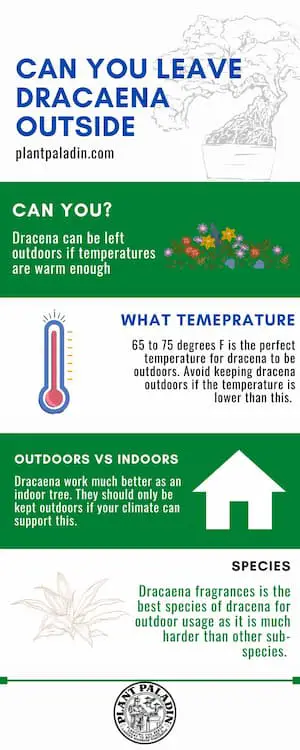This website is supported by its readers. If you click one of my links I may earn a commission. I am also a participant in the Amazon affiliates program and I will also earn a commission from qualified purchases.
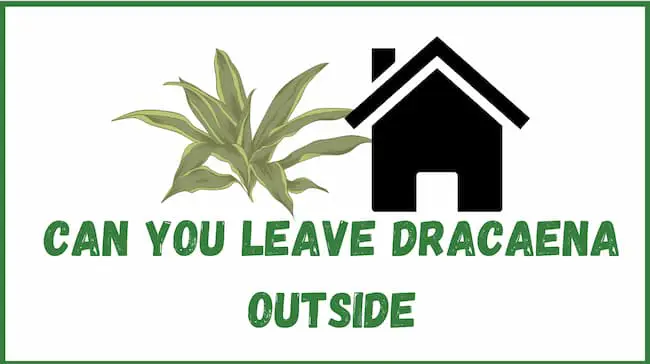
So with winter fast approaching, I’m paying closer attention to some of the houseplants I own, mainly the two dracena. So while Dracaena is commonly known as a houseplant, can you leave Dracaena outside?
You can leave Dracaena outside as they can thrive both indoors and outdoors. However, if placing dracena outdoors, ensure temperatures don’t stay below 50 degrees F (10c) for long periods. The ideal temperature range for dracena to thrive outdoors is 65 to 75 degrees F (18 to 23 degrees C)
Location and providing adequate protection will be vital if keeping dracena outdoors.
If a sudden cold snap emerges outside, you can cover your dracena to protect it from cold temperatures and frost in the short term.
This article will discuss everything you need to know about the Dracaena plant and if it can be left outside. We’ll go over the plant’s natural habitat, ideal growing conditions, and if it can tolerate being outside in different weather conditions.
Just a quick heads up, over the past three years of running Plantpaladin, hundreds of people have asked for product recommendations. As such, You can find my favorite indoor bonsai tree here (link takes you to Bonsaiboy), my favorite outdoor bonsai tree (link takes you to Bonsaiboy), or have a look at all the products I recommend here.
Can You Leave Dracaena Outside?
The Dracaena is a genus of about 120 flowering plants native to Africa, Madagascar, and southern Asia. The Dracaena is widely known as a houseplant but can also be found outdoors in some tropical and subtropical climates.
Dracaena is a popular plant because it is easy to care for and can tolerate many growing conditions.
To get to the bottom of if you can leave Dracaena outside, I got in touch with my local botanical gardens and reached out to 5 plant paladin readers.
To summarise:
- Most species of Dracaena can thrive outside.
- Dracaena can’t tolerate extreme cold. So, avoid keeping them outside during winter if you live in a cold region.
- Don’t keep them under direct sunlight. Dracaena leaves will start to scorch if kept under direct sunlight.
- The ideal temperature range to keep dracena outdoors is 65 to 75 degrees Fharnehight or 18 to 23 degrees Celsius.
- For most of us living in mild climates, keeping Dracaena outdoors is only a viable option in the summer.
- Keeping Dracaena outdoors when cold is not viable as it can lead to frosted soil and browned brittle leaves.
- The best species of Dracaena you can keep outdoors year-round is the Dracaena Fragrans.
What species of dracena can be kept outdoors?
Dracula fragrances have the best chance of surviving outside throughout the year. Most dracaena species, however, will only thrive from the spring to the fall or when temperatures are between ^5 to 75 degrees F
Here’s a table showing what species of Dracaena you can keep outside and how long for:
Species | Time |
Dracaena fragrans | Can be kept outside all year long. |
Dracaena marginata | Can be kept outside from spring to fall |
Dracaena sanderiana | Can be kept outside from spring to fall |
Dracaena deremensis | Can be kept outside from spring to fall. |
Dracaena reflexa | Can be kept outside from spring to fall |
Some species of Dracaena can be kept outside all year long, while you can only keep others outside for part of the year.
If you need to know whether you can keep your dracaena plant outside, a general rule of thumb would be to only keep your dracena outdoors during the summer when temperatures are at their warmest.
Place the dracena in a shady spot in your garden, and you will limit your dracaenas’ chances of burning.
Is Dracena An Indoor or Outdoor Plant?
Dracaena are tropical plants and work better as indoor plants than outdoor plants. However, most dracena can be kept outdoors during warmer springs and summer months.
Before we can discuss whether or not you can leave Dracaena outside, it’s essential to understand what kind of plant it is. Dracaena is classified as a tropical evergreen tree.
That means it is typically found in warm climates and does not lose its leaves in winter. It is not, however, a real tree. Instead, it is more closely related to lilies and yams.
What does that mean for you if you’re wondering if you can leave Dracaena outside?
Tropical evergreen trees are not well-suited to being outside in cooler climates. If you live in a place with cold winters, it’s best to keep Dracaena as an indoor plant.
But Dracaena is a sort of exception to this rule. It is more tolerant of cooler temperatures than most other tropical evergreen trees.
That’s why it’s known to thrive indoors and outdoors in many parts of the world.
If you live in a place with mild winters, you can leave Dracaena outside without any problems.
The Benefits of Growing Dracaena Outdoors
There are several benefits to growing Dracaena outdoors.
First, Dracaena is a very resilient plant that can tolerate many conditions.
It is not picky about soil type and can even grow in poor or sandy soil.
Second, Dracaena is very tolerant of both heat and cold. It can withstand temperatures as low as 10 degrees Fahrenheit and as high as 100 degrees Fahrenheit. This makes it an ideal plant for many different climates.
While your dracena can survive in temperatures as low as 10 degrees F, aim to keep it at a healthy temperature range of between 65 to 75 degrees F
Third, Dracaena is relatively drought-tolerant. It does not need a lot of water to thrive, so you won’t have to worry about watering it every day. Fourth, Dracaena is relatively low-maintenance. It does not need to be fertilized often and can even go several weeks without water.
Finally, Dracaena is a lovely plant. It has long, glossy leaves in various colors, including green, yellow, red, and purple, allowing you to have a more aesthetically pleasing garden or backyard.
What you need to know about growing Dracaena outdoors
While dracena can be grown outdoors, there is a reason most people opt to keep them indoors.
The following, then, are the significant disadvantages of growing Dracaena indoors.
They Can Not Tolerate Cold
The most significant factor is temperature. Dracaena plants are native to tropical regions and cannot tolerate cold temperatures.
If the temperature dips below 50 degrees Fahrenheit (10 degrees Celsius), the plant will experience damage. If you live in an area with cold winters, you’ll need to bring your Dracaena inside when the temperature drops.
Aim to keep Dracaena in a healthy temperature range between 65F and 75F year round.
Dracaena Prefer Indirect Sunlight
Another factor to consider is sunlight.
Dracaena plants prefer bright, indirect sunlight. If they are exposed to direct sunlight, their leaves will scorch.
This is especially true for the variegated varieties of Dracaena, which are even more sunlight-sensitive.
So, if you’re going to leave your Dracaena outside, ensure it’s in a spot where it will get some shade during the day.
Not frost tolerant
You need to provide some protection from the element for your Dracaena.
Dracaena is not tolerant of frost, so choosing a location that is not prone to freezing temperatures is crucial.
If you live in an area with harsh winters, you may need to bring your Dracaena indoors during the colder months.
What Climates Can Dracena Grow Outdoors Best?
Dracena is a tropical plant that grows best in warm and humid climates. It can tolerate shade but prefers to be in an area with bright, indirect light. If you live in an area with a lot of sun, you can grow Dracaena outdoors in a shaded area.
It is also essential to ensure the plant has good drainage, as it does not like wet or soggy soil.
It might be risky to try to grow Dracaena if you live in zone 9, which is known to have freezing temperatures.
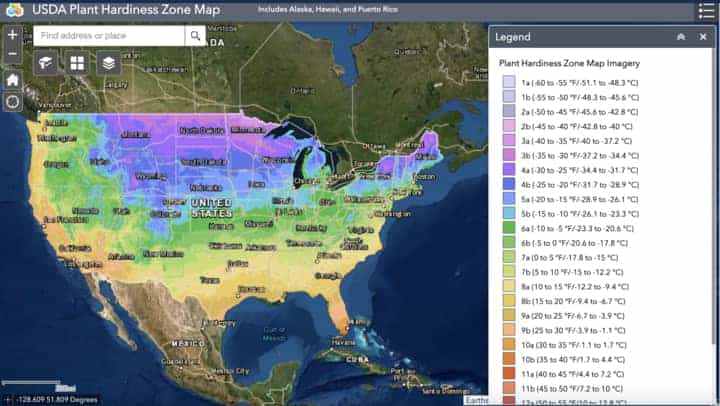
If you want to try to grow Dracaena outdoors in this climate, choose a spot that is sheltered from the wind and make sure that the soil is well-draining.
You should also bring the plant indoors or cover it with a frost blanket if there is a chance of frost.
What Countries Can You Successfully Grow Dracena Outdoors In?
Dracaena Marginata can be grown outdoors in the UK, USA, Canada, Australia, and India. Dracaena Reflexa can be grown outdoors in the UK, USA, Canada, and Australia.
Warneckii Dracaena can be successfully grown outdoors in the UK, USA, Canada, and Australia. Finally, Dracaena Fragrans can be successfully grown outdoors in India.
Here’s a table showing a comparison of the Dracaena species’ ability to remain outdoors in these countries:
Species | UK | USA | Canada | Australia | India |
Dracaena Marginata | Yes | Yes | Yes | Yes | Yes |
Dracaena Reflexa | Yes | Yes | Yes | Yes | No |
Dracaena Warneckii | Yes | Yes | Yes | Yes | No |
Dracaena Fragrans | No | No | No | No | Yes |
Can Dracena Live Outside During Different Seasons?
Dracena can survive outside in warm weather conditions but should be brought indoors during the cooler months. It can tolerate a wide range of temperatures but prefers between 60-80 degrees Fahrenheit.
Here’s a table showing which Dracaena species can tolerate which outdoor conditions:
Species | Spring | Summer | Fall | Winter |
Dracaena Marginata | Yes | Yes | Yes | No |
Dracaena Reflexa | Yes | Yes | Yes | No |
Dracaena Warneckii | Yes | Yes | Yes | No |
Dracaena Fragrans | No | No | No | Yes |
How To Plant a Dracena Outside?
Now, it’s time for us to learn how to plant a Dracena outside. This process is simple and easy, but there are a few things you need to know before you get started.
First, you need to gather all the necessary tools and materials.
For this project, you will need a shovel, a spade, a garden hose, and a watering can. You will also need some potting soil, a container, and rocks or gravel.
Once you have your materials, it’s time to start.
Here are the steps that you need to take:
Step 1: Find the Perfect Spot
The first step is to find the perfect spot for your Dracena. This plant prefers to grow in full sun or partial shade. It also needs well-drained soil.
Check for these conditions in your yard before you begin digging. And make sure that the spot you choose is big enough to accommodate the roots of your plant.
Step 2: Dig a Hole
Once you’ve found the perfect spot, it’s time to start digging. Use your shovel to dig a hole twice your container’s width and just as deep.
Step 3: Loosen the Soil
After you’ve dug the hole, use your spade to loosen the soil around the edges. This will help the roots of your plant to spread more quickly.
Step 4: Add the Soil
Now, it’s time to add some potting soil to the hole.
You want to fill the hole about halfway. Then, use your garden hose to water the soil until it is moist.
Step 5: Place the Plant
Carefully remove your Dracena from its container and place it in the hole. Make sure that the roots are covered with soil.
Then, backfill the hole with the remaining soil.
Step 6: Tamp Down the Soil
Use your hands or a garden tool to tamp down the soil around the base of your plant. This will help to secure it in place.
Step 7: Water the Plant
Once you’ve finished planting your Dracena, water it well, and use your watering can give it a good soaking. Then, keep the soil moist but not wet.
And that’s it! Now, all you have to do is wait for your plant to grow.
Where Is The Best Place To Put Your Dracena Plant Outdoors?
This part is a bit tricky as there are many types of Dracena plants, and each type has different light requirements. However, the best place to put your Dracena plant outdoors is in a spot with partial sun and shade.
Look for a spot where your plant will get direct sunlight in the morning or afternoon but not all day long. If you can’t find a spot like that, try putting your plant in a spot that gets filtered sunlight all day.
Problems With Leaving Dracena Outside
Like anything else, leaving Darcena outdoors comes with a few unique problems. This section will discuss some of the problems you may encounter if you choose to leave your Dracena outside.
Pest and Disease Problems:
One of the most common problems people face when leaving their Dracena outside is pest and disease problems. Pests such as aphids, mealybugs, and scale can infest your plant and cause much damage.
Diseases such as root rot and leaf spot can also be problematic if you leave your Dracena outside.
In a separate post, I wrote about weird brown spots on the Dracena plant; you can check it out by clicking here.

Weather Damage
Another problem you may encounter if you leave your Dracena outside is weather damage.
It can damage your plant if the weather is too hot or too cold.
Also, your plant can get waterlogged and rot if it rains too much.
Soil Problems
If you leave your Dracena outside, you may also encounter soil problems. The soil can become compacted and hard, damaging your plant’s roots.
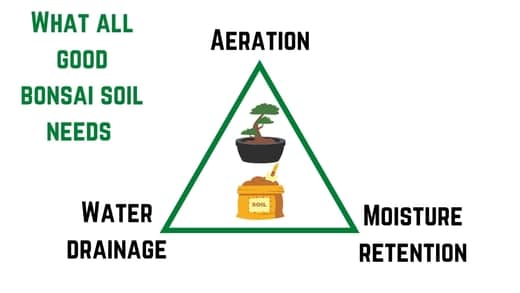
Animal Damage
Another problem you may encounter if you leave your Dracena outside is animal damage. Animals such as rabbits, deer, and mice can all damage your plant. Also, did you know rabbits and deer can eat Dracena?

Poor Drainage
If you leave your Dracena outside, you may also come across poor drainage. If the soil does not drain well, it can cause your plant to rot.
Wind Damage
Another problem you may encounter if you leave your Dracena outside is that the plant is susceptible to wind damage. The plant leaves can easily get damaged by strong winds, so protecting the plant from the wind is essential.
Can Dracena Survive Direct Sunlight?
Leaving Dracaena in direct sunlight will damage and kill the plant’s leaves. It will scorch the leaves, causing them to brown and drop off. Your plant needs indirect sunlight, so putting it in an east or west-facing window is ideal.
Should You Plant Dracena In a Pot or The Ground Outdoors?
If planting dracaena outdoors, aim to plant in a pot instead of directly in the ground. This is because most of us will need to move Dracaena indoors as temperatures drop, so it will be much easier to move in a pot than having to dig up and repot the Dracaena.
Dracaena can be planted in a pot or on the ground outdoors. However, it’s always a good idea to check your local planting zone to ensure the plant will thrive in your area.
What is too cold for Dracaena?
Temperatures below 10 degrees F (-12C) are too cold for dracena. At these temperatures, frost damage will build up on the pant, and the tree will not be able to absorb water or nutrients, effectively killing the plant. For best results, aim to keep dracena in a temperature range between 65F to 75F.
Survey results
I didn’t want to give my opinion; instead, I undertook a quick survey of five plant paladin readers, asking them if they had left their Dracaena outside.
To summarise:
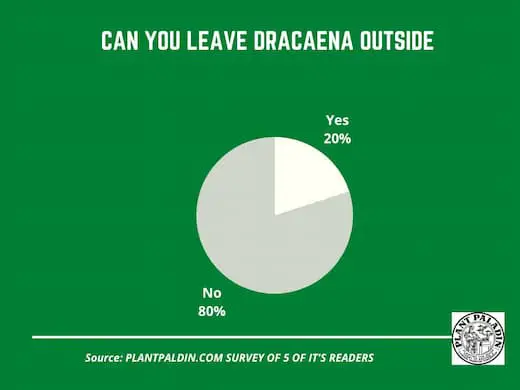
Wrapping Up
After all that discussion about growing Dracaena outdoors, it should be no surprise that most of them are grown as houseplants.
Their attractive foliage, easy care, and ability to tolerate a wide range of growing conditions make them a perfect indoor plant for novice and experienced gardeners.
So, if you’re looking for a plant that will add a touch of elegance to your home, consider growing a Dracaena.
My top picks for the gear you will need!
So like I mentioned earlier, over the past three years of running PlantPaladin, hundreds of people have asked me for my recommendations on the best bonsai gear on the market.
Having spent thousands of dollars on bonsai items these past few years and tested at least 100 bonsai-specific products, I’ve listed my favorite products below – All of which I highly recommend and think you can get great value.
They can purchase directly by clicking the link to take them to Amazon.
Bonsai Tool Set: One of the significant challenges I’ve had is finding a toolset that was not only durable but didn’t break the bank. SOLIGT has recently developed a fantastic bonsai tool set that covers all the tools you need to trim, prune, and repot your trees. – You can grab it here.
Complete Bonsai Set: Many of you will want to grow your bonsai trees entirely from scratch, but finding the varicose seeds, pots, and other items in one place can be challenging. Leaves and Sole then have created a complete bonsai set that I’ve personally used that ticks all the boxes. You can grab it here.
Bonsai wire: The number of times I’ve run out of wire for my bonsai or purchased cheap bonsai wire that doesn’t do the job is embarrassing for me to admit. After a lot of trial and error, I found that using Hotop’s aluminum bonsai wire is one of the best options on the market. This can easily be used for both indoor and outdoor bonsai. You can grab it here.
This post was written by Fehed Nicass, who has been passionate about bonsai for over three years.

